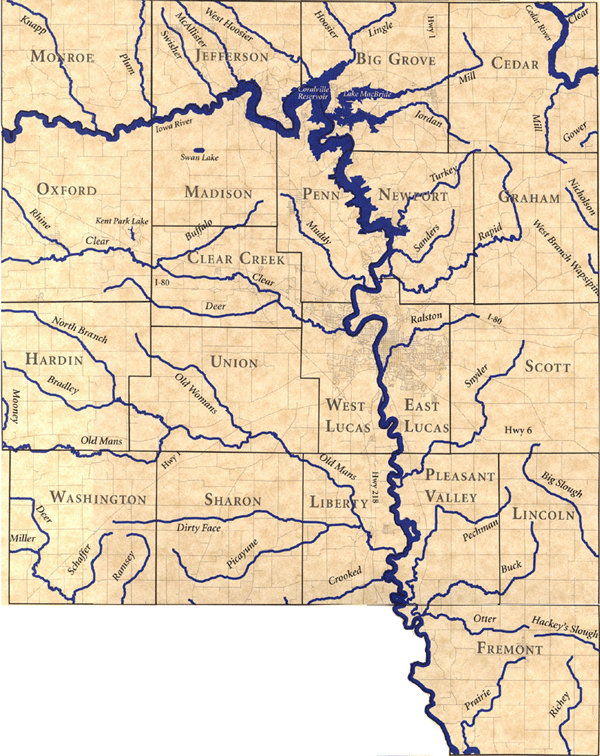Big Slough
A slough (slew) is a marshy wetland area, part of a "back water"
system in a watershed.
Buck
C. H. Buck was the first treasurer for the city of Iowa City in 1853.
Buffalo
Named for very early four legged resident of the prairie lands, also known as
"bison".
Clear Creek
Called in Indian tongue "Capi-hammet" clear water, a beautiful
stream taking its rise in
Iowa County and dividing the township in two parts in very nearly the middle.
Named
by Sheriff Trowbridge because of its clear flowing water.
Crooked
Left on its own, a creek meanderís through level land.
Deer
Another four legged resident of the area.
Deer
Two creeks in the county have this name.
Dirty Face
A family by the name of Morris lived upon it, and had so many children with
frightfully dirty faces.
Hackeys Slough
Who is Hackey??
Jordan
A Mr. Clarkson fell into an unknown stream. He said laughingly that he had
been "dipped in Jordan."
The joke hitched on so well to the disputes about true Bible baptism that it was
kept agoing; and that
stream has been called Jordan creek ever since.
Knapp
Named for early settler in township (?). A Joseph Knapp was killed in a Civil
War battle in 1864.
Lingle
Mr. Lingle built a flouring mill on this stream in 1849. The mill was later
known as "Bohemian Mill."
McAllister
With W. M. Stewart, made the first settlement in 1839. James McAllister
erected the first cabin.
Mill
The first saw mill in the townsihp was located on it in 1839. Previously
known as Sells Creek after
Anthony Sells, early settler who built a mill there. The mill was later known as
"Hendricks Mill."
Muddy
Perhaps the waters were clouded from water running through the limestone
deposits in the area (?)
Old Mans
The Indians called it Pa-pa-to see-po; Mr. W. F. Smith of Washinton township
says this creek was
a hiding place for the old men, women, and children when the braves went off
"on the war path"
when the Sac and Fox were ready to make a foray on their noncombatants out onto
Pa pa to creek
for concealment, in case they should be worsted in the fight and be pursued down
the [Iowa] river
by their victorious enemies.
Old Womans
Flows into Old Man's. Perhaps an even more remote sanctuary for tribal
noncombatants. | Otter
Short legged, heavy-bodied, swimming mammals, otters live on fish.
Pechman
???
Picayune
Picayune was the name given in New Orleans to the old Spanish 6 1/4 cents and
later to the
American silver 5 cent piece, the charge for ferrying a man afoot across the
river. Got its name
from a business deal. A man on that creek charged his neighbor a picayune for
salting his calf.
The man was old Squire Figg, who paid the price, and out of revenge called the
creek on
which the family lived, Picayune Creek.
Prairie
The "lone tree" in this area was a large white elm, and was the
only tree on the PRAIRIE,
and could be seen for many miles... no other trees for miles around excepting
for some four
miles toward the river.
Ralston
Once of the three commissioners who were charged with selecting the site for
the capitol
building in Johnson County. From Burlington, Ralston was a member of the first
territorial legislature. Ramsey
??
Rapid
Named by Sheriff Trowbridge on account of its roaring, rushing rapid
character, especially at the
part where Henry Felkner built his saw-mill in 1839-40.
Rhine
Flowing into Clear Creek SE of Oxford, head waters in Iowa county near German
settlement of
Homestead. Sometimes called the "Raging Rhine." May have been called
"Cook Creek" after
early settlers in the Oxford area.
Richey
N. B. Richey came to Johnson County in December of 1864 where he now lives
and own
240 acres of land and has it well improved.
Sanders
Cyrus Sanders (?) was a prominent early settler of Johnson County.
Schaffer
Perhaps named for Erlis Schaffer. Flows into Deer Creek
Snyder
Wm. B. Snyder???
Swisher Benjamin Swisher from Ohio settled in this township in 1841.
Turkey
Named by Sheriff Trowbridge, good place to hunt wild turkeys.
Wapsi
Head waters for Wapsinonoc Creek, flows to West Liberty then to the Cedar
River.
West Hoosier
Settlers in the area came from Indiana, the "Hoosier State." Source: Johnson
County Soil & Water Conservation District |
